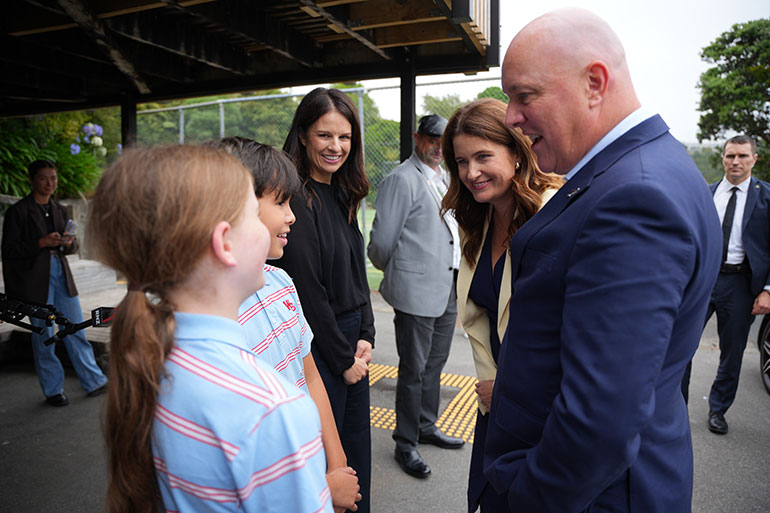Developing Talent
Updated 23 September 2025
Businesses thrive when they can tap into a workforce equipped with the skills to drive innovation and growth. Individuals thrive when they have the skills and qualifications to secure fulfilling and ongoing employment.
On this page
The Government is actively investing in ensuring New Zealand’s skills and education system is again world-class – so all students and workers can get strong foundations in literacy, numeracy, and learning skills. The Government is also ensuring that our immigration system complements the domestic skills pipeline, attracting the talented and skilled people needed to drive long-term business performance.
Since Going For Growth began, the Government has built on earlier progress to deliver a further 10 actions that include:
- investing in Teaching the Basics Brilliantly to reverse the long-term decline in student achievement through the provision of additional school-based teaching resources and focused training
- investing to support job seekers under 25, including those with health conditions or disabilities, move into employment, education or training rather than go on or stay on a benefit
- refining the Accredited Employer Work Visa to reduce compliance and costs for business and address unacceptable levels of migrant exploitation
- introducing 2 new residence pathways to help employers attract and retain skilled migrant workers and boost the economy in turn – with changes to be implemented in mid-2026.
Responding to the needs of businesses
The Government is actively listening to the business community to understand their needs. Businesses have told us they want the New Zealand education system to be more effective in preparing individuals with the skills they need. To this end, the Government is consulting with the public on proposals to replace NCEA with new national qualifications. The intent is to make sure our qualifications:
- are credible, easy to understand and internationally comparable, and
- support high-quality, coherent learning programmes.
Business also wants improved vocational pathways, effective training programmes, and speedier visa processes for people with critical skills. The actions set out in Going For Growth respond to these challenges. Together, these actions are growing the number of skilled people in New Zealand and supporting their pathways into the workforce.

The Prime Minister, Education Minister and Economic Growth Minister with students.
Case Studies
New Skilled Residence Pathways to Boost Economic Growth
Recently announced changes to New Zealand’s Skilled Migrant Category (SMC) introduce 2 new residence pathways to attract and retain skilled migrants to support economic growth:
- Skilled Work Experience Pathway: For migrants with at least 5 years of relevant skilled work experience, including 2 years in New Zealand earning at least 1.1 times the median wage. This helps retain experienced workers, particularly in high-demand sectors like manufacturing and construction
- Trades and Technical Pathway: For migrants with a relevant Level 4+ qualification and 4 years of post-qualification skilled work experience, including 18 months in New Zealand earning at or above the median wage. This supports skilled trades and technician roles, many of which play a critical role in regional economies.
Additional eligibility restrictions will apply to some occupations, with details to be released before the pathways open in mid-2026. An estimated 3,500–9,000 skilled migrants could benefit from these new pathways in the first year.
Other SMC changes include increased points for New Zealand university-level qualifications, making it faster for international graduates to gain residency. For example, a New Zealand Bachelor’s degree holder now needs only 1 year of skilled work experience, down from 3.
Other SMC changes include increased points for New Zealand university-level qualifications, making it faster for international graduates to gain residency. For example, a New Zealand Bachelor’s degree holder now needs only 1 year of skilled work experience, down from 3.
Refining the Accredited Employer Work Visa
Immigration settings have been changed to attract the right migrants to fill critical skills and
labour gaps. The Accredited Employer Work Visa – our main temporary work visa that allows migrants to live and work in New Zealand for 3 to 5 years, with a job offer from an accredited employer – now has faster processing times, with more flexibility and lower administrative costs for businesses that are hiring.
The changes to the Visa, announced in December 2024 and implemented throughout 2025, have provided much needed support to employers. Federated Farmers described the changes as "a significant step forward" and noted that their concerns had been listened to, and that they are "big changes that will have a meaningful impact for the upcoming farming season, particularly during busy periods like calving and lambing".
For example, farmers employing migrants as dairy farm workers now face dramatically reduced processing times, from an average of 83 working days in December 2023 to an average of 15 working days in March 2025. The Visa now also provides employers with the flexibility to pay workers an appropriate wage for their level of skills and experience.
Investing in Teaching the Basics Brilliantly
Teachers are now benefitting from government investments in teacher training, specialist staff,
guidance, and classroom resources that will transform how our children learn to read.
Structured literacy is being implemented through Years 0-8 and professional learning and development has been provided to more than 23,000 teachers.
New teaching and learning resources for mathematics and Pāngarau are providing teachers with greater clarity, structure, and support. Almost 2,000 schools have received these resources, with teachers reporting improved clarity and a shift to focusing on core mathematical ideas in greater depth.
Through these actions, the Government is investing heavily to reverse the long-term decline in student achievement.

Supporting our students with more structured literacy resources, Education Minister and student pictured.
Investing in Supporting Young People Under 25 Years Off Benefit and into Employment, Education and Training
The Government has invested in community-based job coaches for up to 10,000 young people on a benefit to support them into work. Job coaches hold young people accountable in achieving their plans to get back into work, education or training. To further incentivise young people into work, eligible clients who find work with the support of their job coach and remain off the benefit for 12 months will receive a $1,000 bonus payment.
Case management support has expanded for the wider benefit population, with places increasing from 60,000 to 70,000, including 6,000 18-24-year-old clients in phone-based case management. Case managers work with young people to help them into employment by assessing their needs, setting goals and providing practical help, such as getting an up-to-date CV or a driver’s licence.
The Government is also tightening access to Jobseeker Support and the Emergency Benefit for single, unemployed 18- and 19-year-olds by introducing a parental assistance test. This change will strengthen financial incentives to encourage young people into employment, education or training.
Through these actions the Government is investing to reduce the number of young people on the benefit.

Construction worker, New Zealand.
Credit: Truestock.
Government’s Actions
As well as the 10 new actions delivered since February in the Developing Talent part of Going For Growth, a further 13 are underway. These include new initiatives to accelerate progress on supporting people into employment.
Delivered since February 2025
- Improved school attendance through tailored approaches to addressing the underlying causes of absence.
Term two attendance higher than pre-covid(external link) — Beehive.govt.nz - Completed Phase 1 of the Attendance Action Plan, including the daily publication of attendance data, the introduction of updated attendance codes during Term 1 2025, and the rollout of a behaviour change campaign. Since the implementation of these initiatives, we continue to see a steady increase in attendance.
Attendance action plan to lift student attendance rates(external link) — Beehive.govt.nz - Allocated nearly $123 million over four years for the delivery of a new attendance service and almost $17 million to support and strengthen frontline attendance services, aiming to reduce chronic absence and lift overall attendance rates.
Getting kids back in school(external link) — Beehive.govt.nz - Commenced investment in new teacher resources and support services, backed by $271 million over four years from Budget 2025.
Budget 2025 at a glance(external link) — Ministry of Education - Made the largest investment into learning support in more than 20 years to support Kiwi kids to better thrive at school, including expanding the early intervention service, which includes 900,000 additional teacher aide hours by 2029.
Largest boost to Learning Support in a generation(external link) — Beehive.govt.nz - Implemented changes to the Accredited Employer Work Visa to make it easier for employers to hire skilled migrants. Changes include amending the labour market test so that employers can self-declare they have advertised with the Ministry of Social Development, removing the requirement to pay the median wage, and speeding up processing — while strengthening protections against exploitation.
Securing the skills and experience NZ needs(external link) — Beehive.govt.nz - Announced a Parent Boost visitor visa to incentivise skilled migrants to choose New Zealand, by making it easier for parents of New Zealand citizens and residents to visit New Zealand.
Bringing families together with Parent Boost(external link) — Beehive.govt.nz - Announced new residence pathways to help employers attract and retain skilled migrants workers – with changes to be implemented in mid-2026.
New residence options to bolster workforce(external link) — Beehive.govt.nz - Introduced Individual Employment Plans to help job seekers overcome barriers to work.
More support to help people on benefit into work(external link) — Beehive.govt.nz - Implemented new tools and requirements to ensure job seekers stay on track with their obligations and engage more frequently with the Ministry of Social Development (MSD).
Social Security Amendment Bill passes into law(external link) — Beehive.govt.nz
Delivered prior to February 2025
- Implemented more regular reporting of school attendance figures to get more students into school and learning.
Daily attendance dashboard is live(external link) — Beehive.govt.nz - Introduced better training and more tools to support teachers in reading, writing, and maths.
More support in reading and maths for Kiwi kids(external link) — Beehive.govt.nz - Introduced structured literacy and mathematics teaching to raise achievement in schools.
Relentless focus on literacy & numeracy at school(external link) — Beehive.govt.nz - Introduced a requirement for 1 hour of reading, writing and maths every day in schools.
First steps of 100-day plan for education: removing distractions and teaching the basics brilliantly(external link) — Beehive.govt.nz - Opened the first charter schools to provide more choice and diversity in the school system, allowing students to learn in ways that are specific to their needs.
First charter schools open for 2025(external link) — Beehive.govt.nz - Launched the Māori Education Action Plan to support higher achievement by Māori students in schools and kura by aligning actions with reporting on attendance and achievement targets and other education reports. This provides an evidence-base upon which we can draw on when considering what works for Māori learners.
Govt delivers Māori Education Action Plan(external link) — Beehive.govt.nz - Introduced a Traffic Light System to help job seekers understand what is required of them and keep track of their obligations while they are receiving a benefit.
Green light for Welfare that Works(external link) — Beehive.govt.nz
New actions since February 2025
- Begun a targeted review of youth support programmes to tackle persistent disadvantage — focusing on key life stages where timely interventions can improve employment outcomes.
- Began establishing 10 new Polytechnics and 8 Industry Skills Boards to better meet the needs of local communities, industries, and the economy.
Ten institutes of technology and polytechnics announced(external link) — Tertiary Education Commission
New Industry Skills Boards announced(external link) — Tertiary Education Commission - Commenced development of a new Tertiary Education Strategy to define long-term strategic direction and priorities for the sector.
Tertiary Education Strategy (TES) 2020-2025(external link) — Ministry of Education - Undertook public consultation on the future of NCEA to explore how to make school qualifications more credible and coherent.
Consultation closes on new national qualifications to replace NCEA (external link)— Beehive.govt.nz
Actions underway prior to February 2025
- Removing red tape in Early Childhood Education to make it more accessible, affordable and effective.
Review recommends ECE regulation shakeup(external link) — Beehive.govt.nz - Beginning the Implementation of Teaching the Basics Brilliantly, a multi-year strategy to provide more teacher resources, services and supports to improve access and consistency in primary and secondary school around testing and delivery of tailored supports.
More support in reading and maths for Kiwi kids(external link) — Beehive.govt.nz - Implementing next steps in the attendance action plan including a step system to set out requirements and expectations for parents, schools, and the Ministry of Education to get students in school.
Attendance action plan to lift student attendance rates(external link) — Beehive.govt.nz - Creating a more responsive vocational education and training system to better meet the needs of students, industry and the economy by moving decision making back to regions, more closely aligned to the people it supports.
Vocational education and training decisions support return to regions(external link) — Beehive.govt.nz - Tightening Jobseeker Support eligibility for single 18-19-year-olds through the introduction of a parental assistance test to support young people into education, training or employment.
Parents to step up for unemployed teenagers(external link) — Beehive.govt.nz - Implementing community job coaches for up to 10,000 young job seekers to support them to overcome barriers to obtaining sustainable employment.
Thousands more young people to get job coaching(external link) — Beehive.govt.nz - Introducing bonus payments to incentivise eligible young job seekers to stay off a benefit for at least 12 months and enter employment.
- Implementing the Employment Investment Strategy 2025-2028 to guide investment in MSD’s employment products and services.
Employment Investment Strategy 2025 - 2028(external link) — Ministry of Social Development - Ensuring immigration settings attract the right migrants, including announcing two new seasonal work visa pathways to be implemented in Dec 2025.
Two new seasonal work visas to grow economy(external link) — Beehive.govt.nz
More information
An update to the Development Talent pillar was published on 23 September 2025:
Going For Growth: Developing Talent update - September 2025 [PDF, 981 KB]
If you want more on Going For Growth including this pillar and why it is key for economic growth see:

